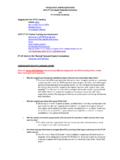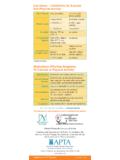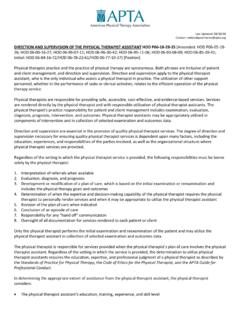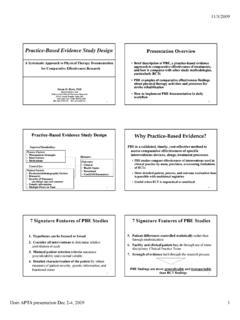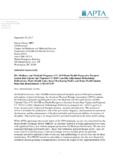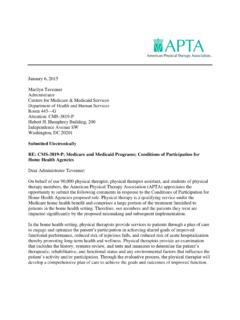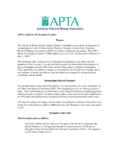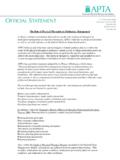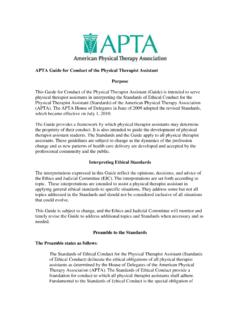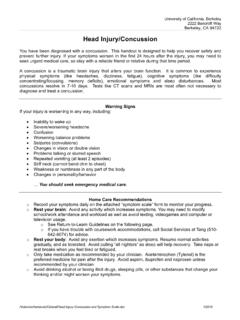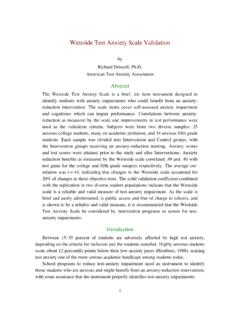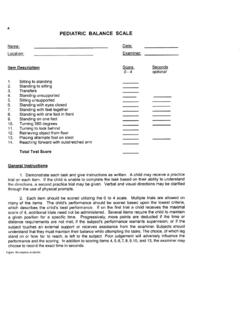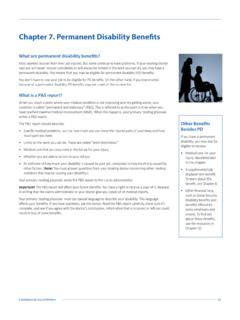Transcription of PEDIATRIC BALANCE SCALE
1 Appendix A PEDIATRIC BALANCE SCALE Name: Date: Location: Examiner: Item Description Score 0-4 Seconds optional 1. Sitting to standing 2. Standing to sitting 3. Transfers 4. Standing unsupported 5. Sitting unsupported 6. Standing with eyes closed 7. Standing with feet together 8. Standing with one foot in front 9. Standing on one foot 10. Turning 360 degrees 11. Turning to look behind 12. Retrieving object from floor 13. Placing alternate foot on stool 14. Reaching forward with outstretched arm Total Test Score General Instructions 1. Demonstrate each task and give instructions as written. A child may receive a practice trial on each item. If the child is unable to complete the task based on their ability to understand the directions, a second practice trial may be given. Verbal and visual directions may be clarified through the use of physical prompts.
2 2. Each item should be scored utilizing the 0 to 4 SCALE . Multiple trials are allowed on many of the items. The child's performance should be scored based upon the lowest criteria, which describes the child's best performance. If on the first trial a child receives the maximal score of 4, additional trials need not be administered. Several items require the child to maintain a given position for a specific time. Progressively, more points are deducted if the time or distance requirements are not met; if the subject's performance warrants supervision; or if the subject touches an external support or receives assistance from the examiner. Subjects should understand that they must maintain their BALANCE while attempting the tasks. The choice, of which leg stand on or how far to reach, is left to the subject.
3 Poor judgment will adversely influence the performance and the scoring. In addition to scoring items 4, 5, 6, 7, 8, 9,10, and 13, the examiner may choose to record the exact time in seconds. B Equipment The PEDIATRIC BALANCE SCALE was designed to require minimal use of specialized equipment. The following is a complete list of items required for administration of this tool: adjustable height bench chair with back support and arm rests stopwatch or watch with a second hand masking tape - 1inch wide step stool 6 inches in height chalkboard eraser ruler or yardstick a small level The following items are optional and may be helpful during test administration: 2 child -size footprints blindfold a brightly colored object of at least two inches in size flash cards 2 inches of adhesive-backed hook Velcro Two 1 foot strips of loop Velcro ** 1.
4 Sitting To Standing *Special instruction: Items #1 and #2 may be tested simultaneously if, in the determination of the examiner, it will facilitate the best performance of the child. INSTRUCTIONS: Child is asked to "Hold arms up and stand up." The child is allowed to select the position of his/her arms. EQUIPMENT: A bench of appropriate height to allow the child's feet to rest supported on the floor with the hips and knees maintained in 90 degrees of flexion. Best Of Three Trials 4 able to stand without using hands and stabilize independently 3 able to stand independently using hands 2 able to stand using hands after several tries 1 needs minimal assist to stand or to stabilize 0 needs moderate or maximal assist to stand c 2. Standing To Sitting *Special instruction: Items #1 and #2 may be tested simultaneously if, in the determination of the examiner, it will facilitate the best performance of the child.
5 INSTRUCTIONS: Child is asked to sit down slowly, without use of hands. The child is allowed to select the position of his/her arms. EQUIPMENT: A bench of appropriate height to allow the child's feet to rest supported on the floor with the hips and knees maintained in 90 degrees of flexion. Best Of Three Trials 3. Transfers 4 sits safely with minimal use of hands 3 controls descent by using hands 2 uses back of legs against chair to control descent 1 sits independently, but has uncontrolled descent 0 needs assistance to sit INSTRUCTIONS: Arrange chair(s) for a stand pivot transfer, touching at a forty -five degree angle. Ask the child to transfer one way toward a seat with armrests and one way toward a seat without armrests. Equipment: Two chairs, or one chair and one bench. One seating surface must have armrests. One chair/bench should be of standard adult size and the other should be of an appropriate height to allow the child to conformably sit with feet supported on the floor and ninety degrees of hip and knee flexion.
6 Best Of Three Trials 4 able to transfer safely with minor use of hands 3 able to transfer safely; definite need of hands 2 able to transfer with verbal cueing and/or supervision (spotting) 1 needs one person to assist 0 needs two people to assist or supervise (close guard) to be safe D 4. Standing Unsupported INSTRUCTIONS: The child is asked to stand for 30 SECONDS without holding on or moving his/her feet. A taped line or footprints may be placed on the floor to help the child maintain a stationary foot position. The child may be engaged in non- stressful conversation to maintain attention span for thirty seconds. Weight shifting and equilibrium responses in feet are acceptable; movement of the foot in space (off the support surface) indicates end of the timed trial. EQUIPMENT: a stop watch or watch with a second han a twelve inch long masking tape line or two footprints placed shoulder width apart 4 able to stand safely 30 SECONDS 3 able to stand 30 SECONDS with supervision (spotting) 2 able to stand 15 SECONDS unsupported 1 needs several tries to stand 10 SECONDS unsupported 0 unable to stand 10 SECONDS unassisted Time in seconds Special Instructions: If a subject is able to stand 30 SECONDS unsupported, score full points for sitting unsupported.
7 Proceed to item #6 5. Sitting With Back Unsupported And Feet Supported On The Floor INSTRUCTIONS: Please sit with arms folded on your chest for 30 SECONDS. Child may be engaged in non-stressful conversation to maintain attention span for thirty seconds. Time should be stopped if protective reactions are observed in trunk or upper extremities. EQUIPMENT: a stop watch or watch with a second hand a bench of appropriate height to allow the feet to rest supported on the floor with the hips and knees maintained in ninety degrees of flexion 4 able to sit safely and securely 30 SECONDS 3 able to sit 30 SECONDS under supervision (spotting) or may require definite use of upper extremities to maintain sitting position 2 able to sit 15 SECONDS 1 able to sit 10 SECONDS 0 unable to sit 10 SECONDS without support Time in seconds E 6.
8 Standing Unsupported With Eyes Closed INSTRUCTIONS: The child is asked to stand still with feet shoulder width apart and close his/her eyes for ten seconds. Direction: "When I say close your eyes, I want you to stand still, close your eyes, and keep them closed until I say open." If necessary, a blindfold may be used. Weight shifting and equilibrium responses in the feet are acceptable; movement of the foot in space {off the support surface) indicates end of timed trial. A taped line or footprints may be placed on the floor to help the child maintain a stationary foot position. EQUIPMENT: a stop watch or watch with a second hand a twelve-inch long masking tape line or two footprints placed shoulder width apart blindfold Best Of 3 Trials. 4 able to stand 10 seconds safely 3 able to stand 10 seconds with supervision (spotting) 2 able to stand 3 seconds 1 unable to keep eyes closed 3 seconds but stays steady 0 needs help to keep from falling Time in seconds 7.}
9 Standing Unsupported With Feet Together INSTRUCTIONS: The child is asked to place his/her feet together and stand still without holding on. The child may be engaged in non- stressful conversation to maintain attention span for thirty seconds. Weight shifting and equilibrium responses in feet are acceptable; movement of the foot in space (off the support surface) indicates end of timed trial. A taped line or footprints may be placed on the floor to help the child maintain stationary foot position. EQUIPMENT: a stop watch or watch with a second hand a twelve inch long masking tape line or two footprints placed together Best Of 3 Trials 4 able to place feet together independently and stand 30 seconds safely 3 able to place feet together independently and stand for 30 seconds with supervision (spotting) 2 able to place feet together independently but unable to hold for 30 seconds 1 needs help to attain position but able to stand 30 seconds with feet together 0 needs help to attain position and/or unable to hold for 30 seconds Time in seconds F 8.
10 Standing Unsupported One Foot In Front INSTRUCTIONS: The child is asked to stand with one foot in front of the other, heel to toe. If the child cannot place feet in a tandem position (directly in front), they should be asked to step forward far enough to allow the heel of one foot to be placed ahead of the toes of the stationary foot. A taped line and/or footprints may be placed on the floor to help the child maintain a stationary foot position. In addition to a visual demonstration, a single physical prompt (assistance with placement) may be given. The child may be engaged in non-stressful conversation to maintain his/her attention span for 30 seconds. Weight shifting and/or equilibrium reactions in the feet are acceptable. Timed trials should be stopped if either foot moves in space (leaves the support surface) and/or upper extremities support is utilized. EQUIPMENT: a stop watch or watch with a second hand a twelve inch long masking tape line or two footprints placed heel to toe Best Of Three Trials 4 able to place feet tandem independently and hold 30 seconds 3 able to place foot ahead of other independently and hold 30 seconds.
